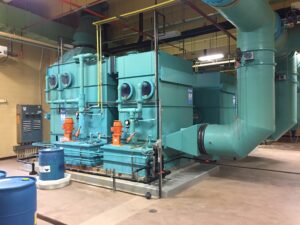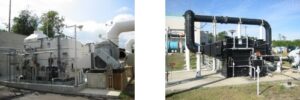How Do Chemical Scrubbers Work? A Practical Guide for City Officials and Plant Operators
 Chemical scrubbers play a key role in controlling odors at wastewater plants and industrial facilities. Yet many city officials and plant operators are not fully sure how they function or when they should be used. We’ll explain the basics in clear, simple terms and outlines where these systems fit best.
Chemical scrubbers play a key role in controlling odors at wastewater plants and industrial facilities. Yet many city officials and plant operators are not fully sure how they function or when they should be used. We’ll explain the basics in clear, simple terms and outlines where these systems fit best.
What Is a Chemical Scrubber?
A chemical scrubber is a system that removes gas-phase pollutants from the air using a liquid chemical solution. It is commonly used to control hydrogen sulfide, ammonia, and volatile organic compounds (VOCs) that can cause strong odors and health risks. These systems can be found at wastewater treatment plants, food processing sites, and chemical manufacturing facilities.
The main components of a chemical scrubber include a contact chamber, spray nozzles, recirculation pumps, and mist eliminators. The contact chamber is where air and liquid interact. Spray nozzles apply a chemical solution across a packed bed, which increases the surface area for treatment. Pumps keep the liquid circulating, and mist eliminators capture any remaining droplets before the treated air leaves the unit.
Step-by-Step: How a Chemical Scrubber Works
To answer the question “how do chemical scrubbers work?” it helps to break the process into steps. First, polluted air is pulled into the scrubber chamber. As the air moves upward or downward through the chamber, it comes into contact with a packed bed sprayed with a chemical solution, often a caustic or acidic liquid.
Odor-causing compounds dissolve into the liquid and react with the chemicals. For example, hydrogen sulfide reacts with a caustic solution to form a non-volatile salt. This reaction neutralizes the odors before the air exits the system. A mist eliminator at the top or bottom of the chamber captures any leftover liquid droplets, leaving clean air to be released. The used chemical solution, now containing neutralized compounds, is collected and either treated or disposed of properly.
When Are Chemical Scrubbers the Best Fit?
Chemical scrubbers perform well when odor loads are high or vary throughout the day. They react quickly, which makes them ideal for sites where conditions change often or where downtime is not acceptable. Facilities that face regulatory deadlines or have strong emissions, such as hydrogen sulfide, benefit from the reliability of these systems.
This type of scrubber is also a good option when other solutions, like biofilters, cannot handle the strength or variability of the odor sources. They are often used as standalone systems or as a first stage in a multi-step odor control setup.
Limitations and Operational Needs
While effective, chemical scrubbers do have operational requirements. Facilities must store and handle chemicals safely. Operators must be trained to manage chemical feed systems and to monitor pH and chemical concentration regularly. Failure to do so can lead to reduced performance.
These systems also have higher operating costs than passive odor control methods because they consume chemicals and require regular maintenance. Pumps, nozzles, and packing media must be checked and cleaned on a routine basis to maintain efficiency.
How WEA Helps Facilities Use Chemical Scrubbers Wisely
 At Webster Environmental Associates, we help facilities determine whether chemical scrubbers are the right choice for their needs. We start by collecting air and liquid samples in the field to understand the type and level of contaminants. Using that data, we design custom systems sized correctly for the airflow and odor load. This attention to detail improves contact time, reduces chemical waste, and keeps the system safe to operate.
At Webster Environmental Associates, we help facilities determine whether chemical scrubbers are the right choice for their needs. We start by collecting air and liquid samples in the field to understand the type and level of contaminants. Using that data, we design custom systems sized correctly for the airflow and odor load. This attention to detail improves contact time, reduces chemical waste, and keeps the system safe to operate.
We often integrate chemical scrubbers with other odor control systems, such as biofilters or covers, to create a complete solution. Our team also trains operators on chemical handling and monitoring procedures and offers ongoing support to keep the system working properly over time.
Why Experience Matters in Scrubber Design
Poorly sized or maintained chemical scrubbers do not perform as expected. In some cases, operators add more chemicals than necessary, which increases costs and creates additional waste. In other cases, inadequate airflow design reduces contact time, allowing odors to pass through untreated.
As experienced industrial odor control engineers, WEA uses modeling and site-specific planning to avoid these issues. We look at emission sources, airflow paths, and space constraints before recommending a design. Our goal is to create a system that works reliably in the field, not just in theory.
Need Help with Odor Control? Contact WEA
Chemical scrubbers can be a powerful tool for wastewater plants and industrial facilities, but they must be designed and managed correctly. If you are considering installing a system or upgrading an existing one, Webster Environmental Associates can help. We work with city utilities, industrial sites, and engineering teams to plan, design, and maintain odor control systems that meet real-world challenges.
Reach out today to schedule a site review or to discuss your options with our team. We will help you find the most effective way to control odors and maintain community trust while staying compliant with regulations.
